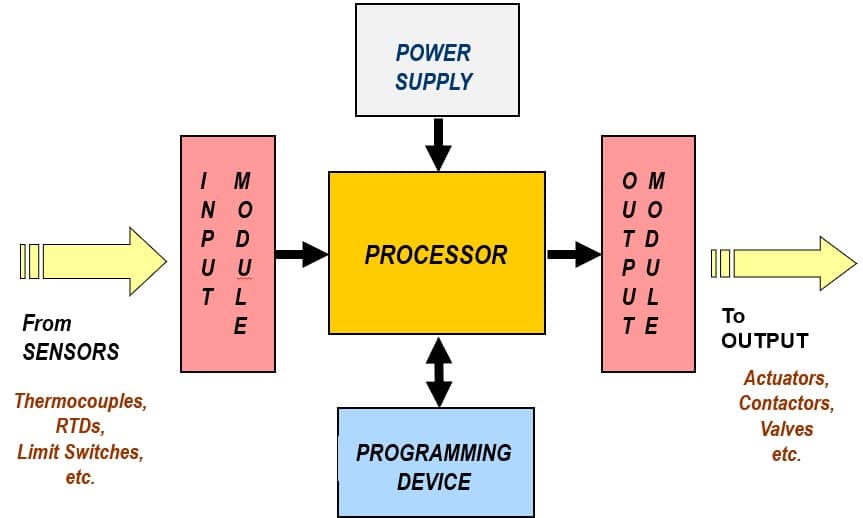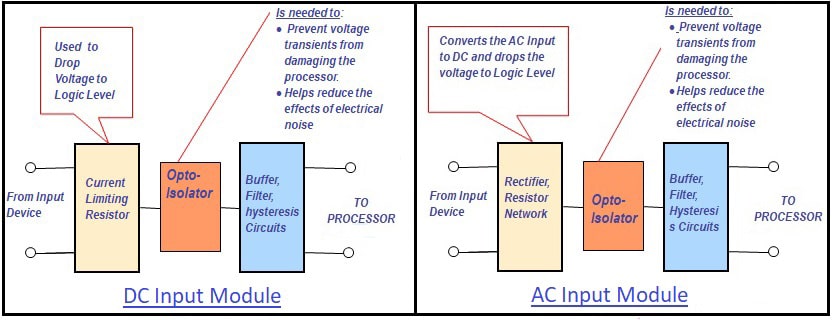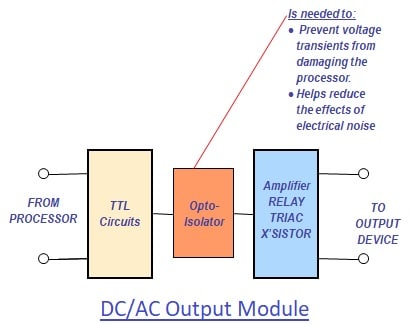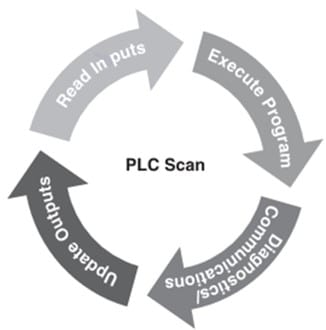What is PLC (Programmable Logic Controller)?
Programmable Logic Controller (PLC) is an Industrial Computer Control System that continuously monitors the state of Input Devices and Makes decisions based on a Customized Program to control the state of Output Devices.
Architecture of Programmable Logic Controller (PLC)

- Central Processing Unit
- Power Supply
- Programming Device
- Input modules
- Output Modules
- Bus System
Central Processing Unit (CPU)
It stores an Internal Program in “Nonvolatile” Memory, meaning that the program will not be lost if power is removed. It tells the PLC how to perform the following functions:
- Execute the Control Instructions contained in the User’s Programs.
- Communicate with other devices, which can include I/O Devices, Programming Devices, Networks, and even other PLCs.
- Perform Housekeeping activities such as Communications, Internal Diagnostics, etc.
Power Supply
It gives the voltage required for Electronics Module (I/O Logic signals, CPU, memory unit and peripheral devices) of the PLC from the line supply.
Programming Device
It is used to Programmed the PLCs. It is Detachable from PLC Cabinet and can be shared by Different Controllers. PCs, Laptops are universally used as Principal Programming Devices.
Input Modules
It connects Input Device, such as a panel or a sensor, to a programmable logic controller (PLC). It acts as interface between real-time status of process variable and the CPU.

Analog Input Module:
Inputs to these modules are 4 -20 mA, 1-5 V signals of Pressure, Flow, Level Transmitters, Ohms and milli Volt from RTD and Thermocouples.
Digital input module:
Input to these modules is 24 V DC, 115 V AC, 230 V AC of Switches, Pushbuttons, Relays, Pumps, Valves on off status.
Output Modules
It acts as link between the CPU and the output devices in the field.

Analog Output Module:
Outputs from these modules are 4 -20 mA, 1-5 V signals to Control Valves, Speed and Vibration devices.
Digital Output Module:
Output from these modules is 24 V DC, 115 V AC, 230 V AC of Switches, Solenoid Valves, lamps, Actuators, dampers, Pump Valve on Off Control.
Bus System
Field bus is designed to replace point-to-point wiring that connects each sensor and actuator to the PLC’s I/O modules.
Operation Cycle of Programmable Logic Controller (PLC)

- PLC scan starts with CPU reading the “Status of Inputs.”
- Application Program is executed using the status of the inputs.
- Once the Program is complete, the CPU performs Internal Diagnostics and Communication Tasks.
- Scan Cycle ends by Updating the Outputs, then starts over again.
- The cycle time depends on the size of the program, the number of I/Os, and the amount of communication required.
RELATED SEARCHES:
Distributed control system (DCS)
